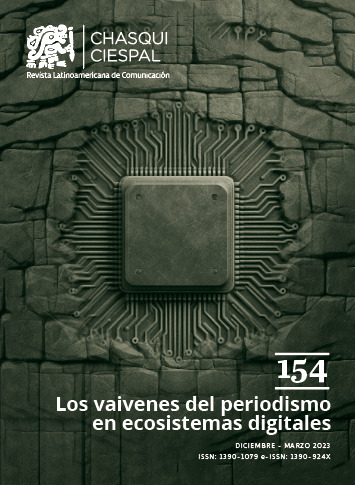Periodismo Automatizado en la práctica: el uso de la generación de lenguaje natural para la cobertura electoral
DOI:
https://doi.org/10.16921/chasqui.v1i154.4935Resumen
El periodismo automatizado es el tema de esta investigación, que pretende revisar los principales conceptos en torno al uso de la generación de lenguaje natural para la producción de noticias. Se argumenta que esta forma de producir noticias combina técnicas de investigación periodística con lenguajes de programación, procesamiento de bases de datos, recursos estadísticos y valores tradicionales de la profesión. Empíricamente, la investigación analiza el proyecto de cobertura automatizada de las elecciones municipales de 2020, realizado por el portal G1, en Brasil. Al final, se afirma que la velocidad y los avances en escala justifican hoy el periodismo automatizado. Sin embargo, es el volumen de datos y su tratamiento lo que permite automatizar las noticias.Referencias
Carlson, M. (2016). Automated journalism: A posthuman future for digital news? In: The Routledge companion to digital journalism studies. Routledge.
Coddington, M. (2015). Clarifying journalism’s quantitative turn: A typology for evaluating data journalism, computational journalism, and computer-assisted reporting. Digital Journalism, 3(3), 331-348.
Clerwall, C. (2014). Enter the robot journalist: Users' perceptions of automated content. Journalism Practice, 8(5), 519-531.
Deuze, M. (2004). What is multimedia journalism? Journalism Studies, 5(2), 139-152.
Diakopoulos, N. (2019). Automating the news. EUA: Harvard University Press.
Duarte, J. (2005). Entrevista em profundidade. Métodos e técnicas de pesquisa em comunicação. São Paulo: Atlas, 1, 62-83.
Dong, C., et al. (2022). A survey of natural language generation. ACM Computing Surveys, 55(8), 1-38.
Dörr, K. N. (2015). Mapping the field of algorithmic journalism. Digital journalism. 4:6, 700-722, DOI: 10.1080/21670811.2015.1096748
Graefe, A. (2016). Guide to automated journalism. Disponível em: https://www.cjr.org/tow_center_reports/guide_to_automated_journalism.php. Acesso em: 16 de agosto de 2022.
Gray, J., Chambers, L., & Bounegru, L. (2012). The data journalism handbook: how journalists can use data to improve the news. EUA: O'Reilly Media, Inc.
Groover, M. P. (2002). Automation, Production Systems, and Computer‐integrated Manufacturing 2nd ed. Assembly Automation. EUA: Pearson.
Latar, N. L. (2015). The robot journalist in the age of social physics: The end of human journalism? In: G. Einav (ed.), The New World of Transitioned Media. Switzerland: Springer, Cham, 65-80.
Latour, B. (2005). Reagregando o Social: uma introdução à teoria Ator-Rede. Salvador – Bauru: EDUFBA - EDUSC.
Latzer, M., et al. (2016). The economics of algorithmic selection on the Internet. In: J. M. Bauer & M. Latzer (eds.). Handbook on the Economics of the Internet. UK: Edward Elgar Publishing, 395-425.
Levy, S. (2012). The rise of the robot reporter. Wired, 20(5), 132-139.
Linden, C. G. (2017). Decades of Automation in the Newsroom. Digital Journalism, 5(2), 123–140.
Marchand, P., & Ratinaud, P. (2012). L’analyse de similitude appliquée aux corpus textuels: les primaires socialistes pour l’élection présidentielle française (septembre-octobre 2011). Actes des 11eme Journées internationales d’Analyse statistique des Données Textuelles. JADT, 2012, 687-699.
McDonald, D. D. (2010). Natural Language Generation. In: N. Indurkhya & F. J. Damerau (Eds.), Handbook of Natural Language Processing (Vol. 2, pp. 121-144). EUA: Routledge.
Meyer, P. (2002). Precision Journalism. 4th ed. Lanham, MD: Rowman and Littlefield.
Örnebring, H. (2010). Technology and journalism-as-labour: Historical perspectives. Journalism, 11(1), 57-74.
Reiter, E., Sripada, S. G., & Robertson, R. (2003). Acquiring correct knowledge for natural language generation. Journal of Artificial Intelligence Research, 18, 491-516.
Rutkin, A. (2014). Rise of robot reporters: When software writes the news. New Cientist, 221(2962), p. 22.
Santos, M. C. (2016). Narrativas Automatizadas e a Geração de Textos Jornalísticos: A estrutura de organização do lide traduzida em código. Brazilian Journalism Research, 12(1), 160-185.
Vajjala, S., Majumder, B., Gupta, A., & Surana, H. (2020). Practical natural language processing: a comprehensive guide to building real-world NLP systems. EUA: O'Reilly Media.
Van Dalen, A. (2012). The algorithms behind the headlines. How machine written news redefines the core skills of human journalists. Journalism Practice, 6(56), 648–658.
Descargas
Publicado
Número
Sección
Licencia
- Los autores/as conservarán plenos derechos de autor sobre su obra y garantizarán a la revista el derecho de primera publicación, el cuál estará simultáneamente sujeto a la Licencia Reconocimiento-SinObraDerivada de Creative Commons (CC BY-ND), que permite a terceros la redistribución, comercial y no comercial, siempre y cuando la obra no se modifique y se transmita en su totalidad, reconociendo su autoría.
- Los autores/as podrán adoptar otros acuerdos de licencia no exclusiva de distribución de la versión de la obra publicada (p. ej.: depositarla en un archivo telemático institucional o publicarla en un volumen monográfico) siempre que se indique la publicación inicial en esta revista.
- Se permite y recomienda a los autores/as difundir su obra a través de Internet.

